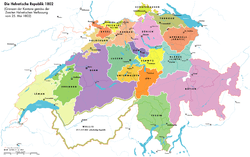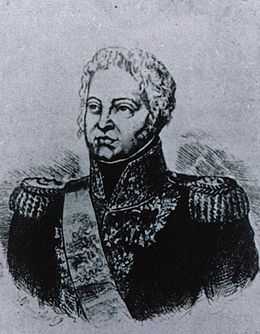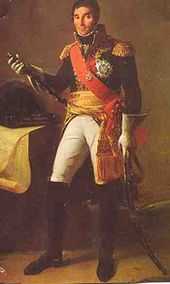Army of Helvetia
The Army of Helvetia, or (French: Armée d'Helvétie), was a unit of the French Revolutionary Army. It was formed on 8 March 1798 from the remnants of the first unit to be known as the Army of the Rhine. It was officially merged into the command structure of the Army of the Danube on 29 April 1799, although it continued to operate in the Swiss theater until 1801. The Army's initial campaigning in the old Swiss Confederation resulted in severe setbacks and defeats at Feldkirch, Lusiensteig, and Zurich.
Background
From October 1797 until 1–2 March 1798, when the French crossed the Rhine into Germany, the signatories of the Treaty of Campo Formio had avoided armed conflict. Several diplomatic incidents undermined this agreement: the reluctance of the Austrians to cede the designated territories; the ineptitude of Second Congress of Rastatt to orchestrate the transfer of additional territories that would compensate the German princes for their losses; the refusal of Ferdinand of Naples to pay tribute, followed by the Neapolitan rebellion; and the subsequent establishment of the Parthenopaean Republic.[1] Other factors contributed to the rising tensions as well. On his way to Egypt, Napoleon had stopped on the Island of Malta and forcibly removed the Knights of Malta from their possessions, angering Tsar Paul I of Russia, who was the honorary head of the order. The French Directory, furthermore, was convinced that the Austrians were conniving to start another war. The weaker the French Republic seemed, the more the Austrians, the Neapolitans, the Russians and the English were discussing this possibility.[2]
The Fall of the Swiss Confederation

On 12 April 1798 121 deputies of the various cantons established the Helvetic Republic by proclamation as "One and Indivisible". The new regime abolished both cantonal sovereignty, or the practice of particular local governance, and feudal rights, and established a centralized state based on the ideas of the French Revolution. This change in governing structure was backed up by military force, through the presence of French soldiers.
Campaigns
| ||||||
Commanders
| Image | Name | Dates | Battles/Campaigns |
|---|---|---|---|
 |
Balthazar Alexis Henri Schauenburg | 8 March 1798– 29 November 1799[3] | Suppression of Peasant uprisings |
 |
André Masséna | 29 April – 29 November 1799 | First Battle of Zurich Second Battle of Zurich |
References
- Citations
- ↑ Timothy Blanning, The French Revolutionary Wars, New York, Oxford University Press, pp. 230-232.
- ↑ Gallagher, John, Napoleon's enfant terrible: General Dominique Vandamme, Tulsa, University of Oklahoma Press, 2008, ISBN 978-0-8061-3875-6 p. 70.
- ↑ (French) Lazare Carnot, Étienne Charavay, Correspondance générale de Carnot: publiee avec des notes, France, Imprimerie nationale, 1894, Volume 2, pp. 474–475.
- Bibliography
- Blanning, Timothy, The French Revolutionary Wars, New York, Oxford University Press, 1996. ISBN 0-340-56911-5
- Gallagher, John, Napoleon's enfant terrible: General Dominique Vandamme, Tulsa, University of Oklahoma Press, 2008, ISBN 978-0-8061-3875-6
- Jourdan, Jean-Baptiste, A Memoir of the operations of the army of the Danube under the command of General Jourdan, taken from the manuscripts of that officer, London, Debrett, 1799.
- Phipps, Ramsey Weston, The Armies of the First French Republic, volume 5: "The armies of the Rhine in Switzerland, Holland, Italy, Egypt and the coup d'etat of Brumaire, 1797-1799," Oxford, Oxford University Press, 1939.
- Rothenberg, Gunther E. (2007). Napoleon’s great adversaries: Archduke Charles and the Austrian Army 1792–1914. Stroud, Gloucestershire: Spellmount. ISBN 978-1-86227-383-2.
- Thiers, Adolphe, The history of the French revolution, New York, Appleton, 1854, v. 4.
- Young, John, D.D., A History of the Commencement, Progress, and Termination of the Late War between Great Britain and France which continued from the first day of February 1793 to the first of October 1801, in two volumes. Edinburg, Turnbull, 1802, vol. 2.